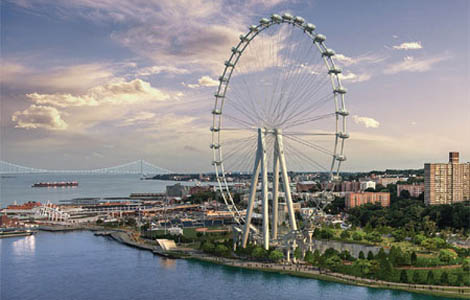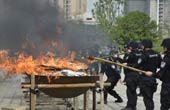Revision of decree protects military airports
Updated: 2014-07-28 07:24
By Zhao Shengnan (China Daily)
|
||||||||
A revised law on protecting military facilities, due to be promulgated on Aug 1, will ensure better security for military airports, more than half of which are obstructed by high buildings overlooking the perimeter.
Height restriction violations have contributed to about 100 flight accidents over the past two decades, Xinhua News Agency quoted military authorities as saying.
The problem has become so severe that more than 10 military airports have had to be relocated or closed, according to the General Staff Headquarters of the People's Liberation Army.
Observers have welcomed the revised law, which forbids the construction of high buildings in military airport reserve zones.
They also called for local governments and the public to be aware of national defense needs amid China's rapid urbanization.
Air safety has been in the global spotlight in recent week after a series of crashes.
In China, more than 1,000 buildings have been found to have breached height restrictions in airport reserve zones, with some of them more than 300 meters higher than permitted, according to the General Staff Headquarters.
Residential activity is also a factor, with pet pigeons and small remotely controlled planes potentially endangering aircraft.
Ma Yifei, an officer at the headquarters, said violations were largely due to the inability of local governments to balance the demands of economic development and national defense.
Wen Bin, a researcher at the PLA's Academy of Military Sciences, said local authorities should not sacrifice national defense for GDP growth through expanding urbanization.
In cases of emergency, military planes may have to detour from their flight paths but the buildings could mean that access to a runway by another approach is blocked, Wen said.
High buildings near an airfield mean that any crash could have a potentially higher death toll, he added.
Apart from the danger to aircraft, even activities such as kite-flying have a deadly potential, while plane-watchers in nearby buildings could gain sensitive information and post it on the Internet.
The PLA Daily last week posted pictures on its website highlighting the security problems near military bases.
One picture showed a home with just one wall separating it from a military arsenal. Another showed that the high wall of a building was obviously in a position that could interfere with a base's radar.
In June, the top legislature passed the revised law, which was originally adopted in 1990, after inspections revealed safety and security risks earlier this year.
The new law clearly defines a "military forbidden zone" and "military management zone".
Xinhua contributed to this story.
zhaoshengnan@chinadaily.com.cn

 Chery automobile plant nearing Brazilian launch
Chery automobile plant nearing Brazilian launch
 42 naval vessels conduct exercises near Hawaii
42 naval vessels conduct exercises near Hawaii
 Brazil launches China desk to handle economic ties
Brazil launches China desk to handle economic ties
 NY Wheel reels in Chinese EB-5 investors
NY Wheel reels in Chinese EB-5 investors
 The Penguins of Madagascar to enter China
The Penguins of Madagascar to enter China
 Film ambassador promotes Chinese films, TV series in US
Film ambassador promotes Chinese films, TV series in US
 Panda cub Bao Bao turns one
Panda cub Bao Bao turns one
 HK kid's symphony returns to NY
HK kid's symphony returns to NY
Most Viewed
Editor's Picks

|

|

|

|

|

|
Today's Top News
China set for long-term increase in US FDI: Expert
Consulate condemns killing of student
iPhones' access to data facing scrutiny
Glitch delays visas for US-bound students
Cooperation with China brings new opportunity to Latin America
Scandal-hit food firm withdrawing products
Chinese USC grad student found dead after attack
US to issue antidumping decision on Chinese solar products
US Weekly

|

|






